1800s United Brethren Revivals


Introduction
With this revival account we will discuss the beginnings of the denomination known as the Church of the United Brethren in Christ. That denomination, with its headquarters now in Huntington, Indiana, had its origins among German-speaking immigrants of eastern Pennsylvania and Maryland.
We will avoid listing many of the names, locations, and dates having to do with the denomination’s start and focus primarily on revivals that occurred and elements that were common in those revivals.
Pentecostal Characteristics of the Revivals
The Second Great Awakening (1790-1840) was a period in the United States when revivals were occurring everywhere simultaneously—in northern New York State, along the eastern seaboard, and even far over into the “western states” of Kentucky, Tennessee, Ohio, and Indiana. Here are a few of the prominent revivals that were occurring at that time.
► 1797 New England Revivals
► 1800 Red River Revival
► 1801 Cane Ridge Revival
► 1813-1847 Revivals in the Old South
► 1815-1840 New York Revivals
What is noticed during this era is that revivals had similar features, in that they were very “Pentecostal” in nature, meaning the church services, camp meetings, meetings in homes, and meetings in open fields were very lively. Some of the features were:
► Shouting
► Clapping
► Falling, whether being “slain in the spirit” (swooning), or overcome with severe conviction of sin.
► Unconsciousness for up to 12 hours or longer, explained as being overcome by the power of the Holy Spirit.
► People entering “states of ecstasy”—having their emotions “transported.”
► Visions, dreams, prophesies, etc.
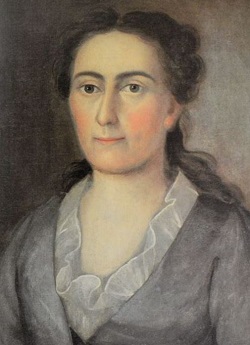
Sarah Edwards
Jonathan Edwards, the leading figure of the First Great Awakening (1730s-1740s), wrote in detail about how the presence of the Holy Spirit’s power affects the human body. These dramatic and tangible encounters with the divine are seen multiple times throughout the Bible, in both the Old and New Testaments, so no honest Bible student can deny this can happen today.
We have a well-documented divine encounter that was experienced by Jonathan Edwards’ wife, Sarah. It was said to have lasted at least 14 days. During that time she experienced “transports of joy” or a “foretaste of heavenly glory.” That account can be read here.
The revivals occurring among the German immigrants during the 1700-1800s, which led to the establishment of the United Brethren, were no different than the revivals that were occurring in other locations in the United States at that time. These revivals all had “Pentecostal features,” and that denomination’s official and accepted history decisively proves this to be true.

P. W. Otterbein, left, and Martin Boehm, meeting in the barn owned by Isaac Long.
The Starting Point
Historians cite a worship meeting occurring sometime after 1766 as being the starting point for the “revival movement” which ultimately led to the formation of the Church of the United Brethren in Christ.
This worship meeting was conducted in a barn owned by Isaac Long, and at the close of the meeting, one of the men present, Philip William Otterbein (1726-1813), greeted the one who was preaching, Martin Boehm (1725-1812), and due to Otterbein sensing a real heart-connection with Boehm, he hugged Boehm and said, “We are Brethren.” That phrase was said to have been the origin of the name for the denomination, the United Brethren.
From the mid-1700s till the early 1800s, the “revival movement,” as it was called, involved meetings that were held mostly in homes, barns, and open fields. Because some of these gatherings were large, consisting of up to 400 people, meetings were held several days in a row, with people setting up tents and camping at the site—bringing food for themselves and their horses. This is how the term camp meeting originated.
As Otterbein and Boehm worked together, and others associated with them, they formed a loose network of ministers and meeting houses (and a very few church buildings), with circuit riders preaching along established circuits of homes or barns. The formal establishment of the denomination occurred in 1800 with the naming of Otterbein and Boehm as the first bishops.
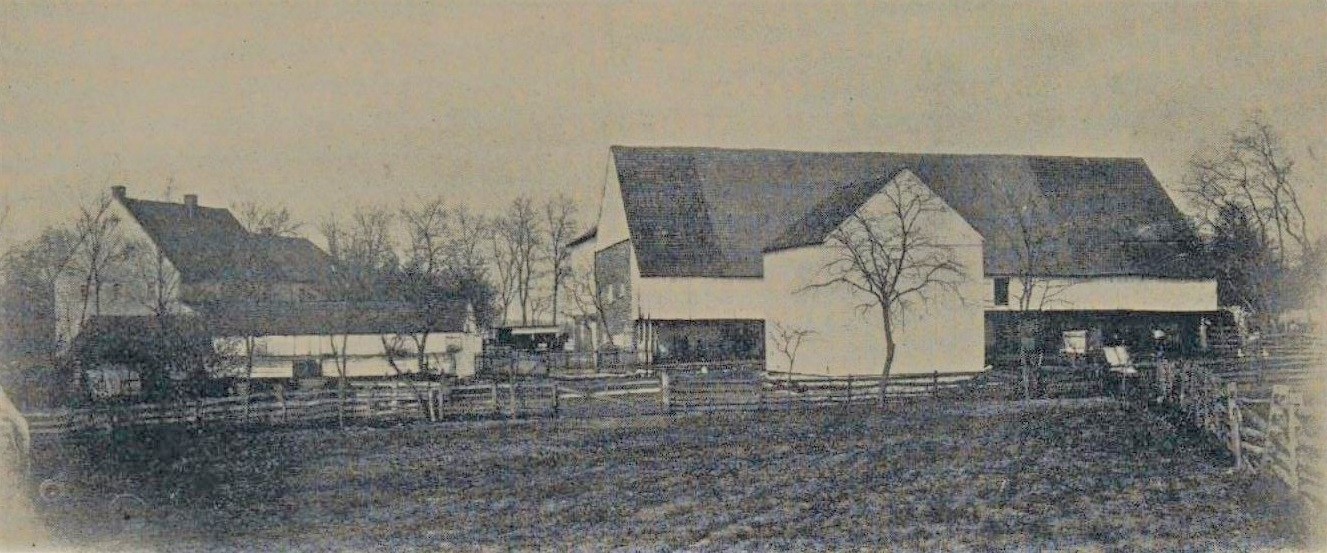
Barn owned by Isaac Long. It was the location where Otterbein and Boehm met. The barn is still being used today and is located here.
Biblical Phenomena
Christian Newcomer (1749-1830), who eventually became the third bishop of the denomination, in 1803 was preaching in a home close to Mount Pleasant, Pennsylvania, and from his journal we have insight into what was common in the meetings of the United Brethren:
Nov. 10, 1803: I had not spoken long before some of my hearers fell to the floor, others stood trembling and crying so loud, that my voice could scarcely be heard.
Nov. 11, 1803: We preached at Mr. Swope’s [house]; here also the power of God displayed itself in a strange and marvellous manner. Several of the congregation fell down apparently lifeless, others shook, trembled, and were agitated in a powerful manner. At night I preached at Mr. Chr. Manensmidts, from 2d. Peter, 1; v. 19; here likewise the people fell down and laid as if in a swoon or fainting fit.
Nov. 12, 1803: A great many people were assembled together to-day; I spoke to them from Hebrews 12; v. 19, with great liberty. The Lord accompanied his word with power; many were the wounded and slain, some of the most stubborn sinners fell instantly before the power of God. The meeting continued the whole night…
Nov. 13, 1803: To-day we had indeed a little Pentecost, from 3 to 400 persons had collected, more than the barn in which we had assembled for worship, could contain… During the time of preaching, several persons fell to the floor, some laid as if they were dead, others shook so violently that two or three men could scarcely hold them; sometimes the excitement would be so great that I had to stop speaking for several minutes, until the noise abated; some few were praising God and shouting for joy.
With revival scenes like this, Mount Pleasant, Pennsylvania became like a new Antioch, from which the Gospel spread throughout the region.
The Methodist Connection
With bishops Otterbein and Boehm being closely associated with the bishop of the Methodist Episcopal Church, Francis Asbury (1745-1816), the “Pentecostal” experiences among the United Brethren were also found among the Methodists (and many other denominations).
We know that the Methodist meetings were filled with this Pentecostal power through the 1850s, as we read from an account of Maria Woodworth-Etter:
When I was a girl the Methodist church was the most powerful and the most spiritual. The people fell under the power of God, shouted, danced, got healed from diseases and did lots of other things.
Genuine Manifestations of the Holy Spirit
An official history of the Church of the United Brethren in Christ, from 1924, states that the phenomena experienced during the foundation of the denomination was similar to the Pentecostal scenes witnessed at the 1801 Cane Ridge Revival, and the denomination said that the phenomena was genuine – meaning that what was experienced during those services were genuine manifestations of the Holy Spirit’s power.
The strange phenomena attending these meetings were much like those attending the great Cane Ridge revival in Kentucky in these same years, and yet the results there are everywhere acclaimed now as a most genuine, far-reaching, and enduring revival of spiritual religion.
Every documented history of the United Brethren that we have found fully endorsed the services that were held by the founders.

By the 1830s the revival movement had reached Ohio and Indiana.
Up to the year 1830 there were only twelve United Brethren churches built:
► Maryland – 1
► Ohio – 2
► Indiana – 1
► Pennsylvania – 8
Though the number of churches was small, they were winning many souls, with churches of other denominations benefiting from their labor.
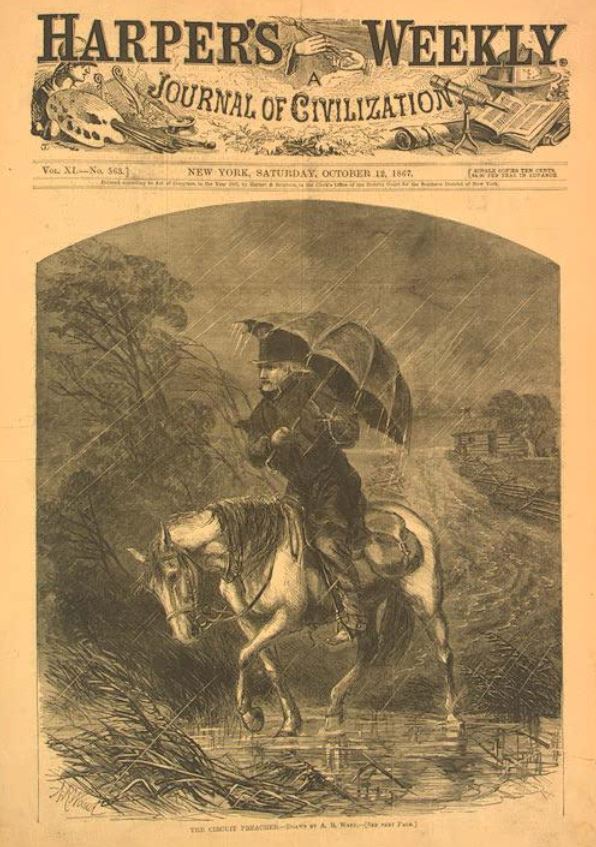
Illustration of a Circuit Rider
Cover of Harper’s Weekly magazine, dated October 12, 1867
Accounts from a Circuit Rider
Rev. Samuel Huber (1782-1868), a circuit rider and highly respected elder of the United Brethren denomination, shows us that the Holy Spirit’s power, like what Christian Newcomer described above, continued at least into the mid-1800s.
Prior to the planting of churches around Chambersburg, Pennsylvania, Huber writes about the types of meetings that were experienced in homes:
In a short time these houses could not contain the people, who would come out to hear the preaching. At one of these meetings held in father Oaks’ house, the Spirit of God came upon the people, like the “rushing of a mighty wind.” Many of them felt the power of God, in a manner they had not experienced it before. There was one general move among them at that time, some shouting, leaping and praising God for his mercy, in filling their hearts with his love, joy, and peace. I felt heaven upon earth within me. Upon the whole, we had a glorious meeting.
While holding a meeting in the home of Huber’s brother, Abraham, Huber gives us this account:
After preaching, I spoke out: “We ought to sing and pray again… I gave out a few verses, sung and prayed…. It took deep root in my brother Abraham’s heart… In an instant, my brother sprang upon his feet and then fell, upon the floor. This he did twice in succession. The third time, attempting to rise up, he fell upon his back, his head resting upon a bench and his feet extended on the floor. In this condition he remained for some length of time, stiff and powerless. After going through this process, he rose up, giving God thanks for his mercies.
They came and preached the Gospel. God seconded their ministry with signs following.
Old and young, men and women, experienced the new birth—and prayed and prophesied. The old dogma, “that women should keep silent in churches,” was lost sight of. Old women and young girls, when their souls were blest and made happy, would break forth into singing—shouting—praising—exhorting—prophesying—and talking about the Saviour in public congregations, to the utter consternation of old dry Pharisees, who beheld this new way with horror and dismay.
Thus was fulfilled the prophecy of Joel, 2:28, 29, “And it shall come to pass afterward that I will pour out my Spirit upon all flesh; and your sons and your daughters shall prophesy, your old men shall dream dreams, your young men shall see visions. And also upon thy servants and upon thy hand maidens in those days, will I pour out my Spirit.” And so it was here, and became marvellous in the eyes of formal professors of religion.
First Camp Meeting Near Rocky Spring, Pennsylvania
Preachers from many different denominations were invited to preach at the United Brethren camp meetings: Presbyterians, Lutherans, Mennonites, Dunkards, River Brethren, etc.
The first Camp Meeting which the Church of the United Brethren in Christ held, was on my brother Abraham’s land, near the Rocky Spring, at which many sinners fell down, through the power of the word preached, as if dead, but rose again, shouting victory.
We can see that these “signs that followed” were common in most all the denominations at this time. The only ones that didn’t experience this power of the Holy Spirit were the pridefully educated or unconverted ministers of that day. Yes, just like today, there are many unconverted ministers.
What the Camp Meetings Looked Like
Huber left us with a description of what these camp meetings were like:
Protracted, or “Big meetings,” were held then, differently from what they are now. Commencing on Saturday afternoon at 2 o’clock, they were continued until the following Sunday afternoon. Sacrament [communion] was then administered, after which the meeting was closed, and the people retired. Many of them with hearts filled and glowing with divine love, frequently parted with shouts of joy, while sympathizing tears rolled down their cheeks.
Definition of a Spiritual Blessing
At the close of that camp meeting at Rocky Spring, Huber received what he described as a “spiritual blessing.” This involved him being overcome by the presence and power of God. Today this is commonly referred to as being “slain in the Spirit.”
Toward the close of this meeting, God gave me such a spiritual blessing, that I was overpowered by it, soul and body. I fell and lay upon the ground for some length of time. After I came to myself and rose up, I felt an inexpressible degree of happiness, which constrained me to offer myself anew to my heavenly Father—”to spend and be spent” in his service; and I resolved, through his grace, to speak more frequently in public, depending on Him for help and strength in every time of need. It must be borne in mind, that heretofore I had not preached.
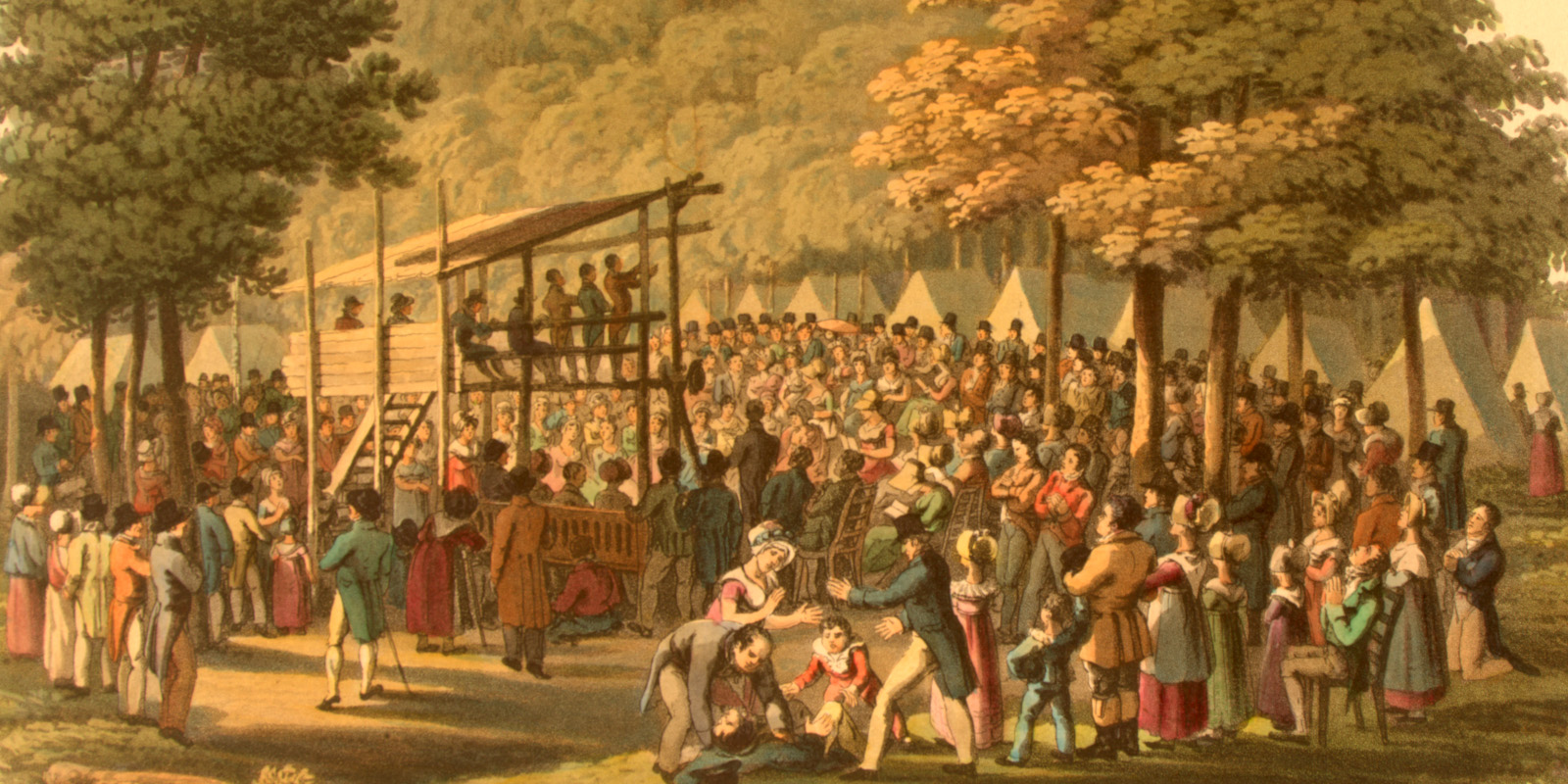 Camp Meeting from that Era (1819)
Camp Meeting from that Era (1819)
Demons and Deliverance from Them
Huber also relates a time when a woman was delivered from demonic influence:
When the people began to gather, she went about the house storming as if seven devils were in her. At length she took her seat in a corner of the room. The religious exercises [meeting] went on. During the time I was preaching, a thunderbolt from heaven entered her heart. She fell upon her knees roaring out for mercy, as if the devils were tormenting her. Singing and prayer were continued. She wrestled on, until the strong man armed was cast out, and a stronger than he, Christ, took possession of her heart before the meeting closed.
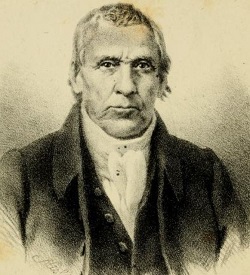
Samuel Huber,
elder and circuit rider.
Samuel Huber was displeased when people would criticize people falling down on the ground in agonizing conviction of sin prior to them surrendering to Christ. He saw this as a battle with demonic powers. In the Bible people would shriek, thrown themselves down, and behave very erratically as they were being released from Satan’s grip and transferred into God’s kingdom. Huber evidently thought, “Why should it be hard to accept that the same can happen today?”
Conviction of Sin—Crying Out for Mercy
A common phenomenon was the overwhelming conviction of sin that accompanied the preaching of the Gospel. People would feel the condemnation weighing down upon them, at times being so heavy that they would lose their physical strength and often fall to the floor, begging God for mercy and forgiveness of their sins.
Here Huber shares a little about that conviction of sin:
When we arrived at the place, there was a wedding party in waiting. Brother Troub tied the knot for them. There was meeting in the evening. I preached. The Holy Spirit wrought powerfully. Seven of the wedding party fell, as men slain in battle, crying out for mercy, and were married to the Lamb of God.
On another occasion while preaching in York, Pennsylvania, Huber shares a similar experience (and there were many such happenings):
The power of God came down like the cataract which thunders down the Niagara, sweeping in its current all before it. Sinners were cut to the heart. Some fell upon the ground, crying aloud for mercy. Others were groaning in agony, unable to express their feelings. Some were shouting, and others looking on with amazement, wondering at such proceedings. So great was the excitement one night, that preaching was dispensed with. Talking to the mourners—singing—and prayer were continued during the night.
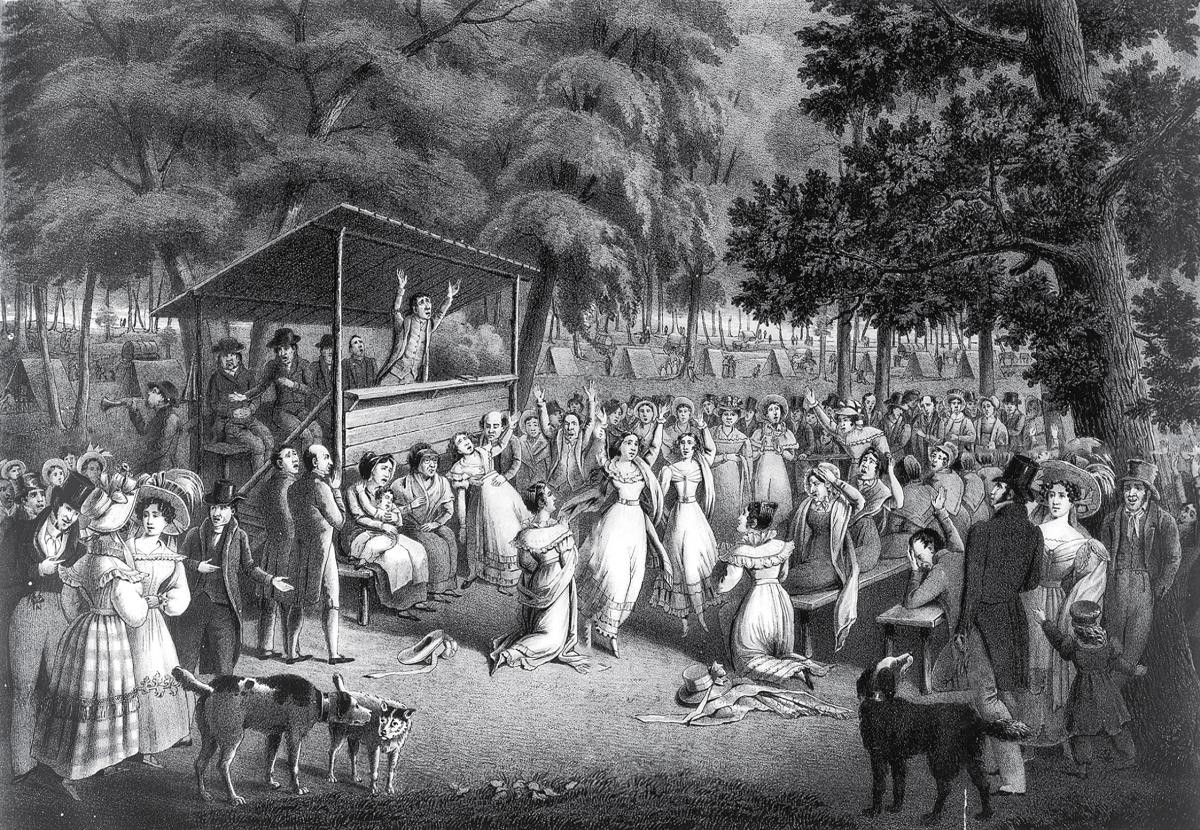
Camp Meeting from that Era (1829)
Struck Unconscious for 12 Hours
Huber shares how three unconverted men were struck unconscious by God’s power, and when they came to about 12 or more hours later, they pled for mercy and were converted.
At one of the camp meetings held near the Rocky Spring, one night, after the people had retired to rest, there were present three young men. What their intentions were, no one knew, probably, but themselves. One of them had a pistol in his hand. They were standing around one of the Camp fires. Suddenly they were struck with the power of God, and fell simultaneously to the ground, with their heads outwards from the fire. In this condition they lay as dead men, apparently without life, until the forenoon of the next day, at which time they began to show signs of life. When recovering, they trembled as though they had the ague [malaria, chills], and began to pray for mercy. After much prayer was made in their behalf, they rose up, praising God, “that the dead were made alive” through his pardoning grace.
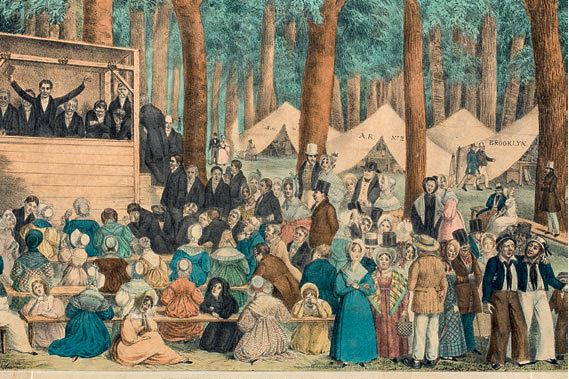 Camp Meeting from that Era (1836)
Camp Meeting from that Era (1836)
Prophecy, Visions, Dreams, Out-of-Body Experiences
We could continue to recount the manifestations of the Holy Spirit that were manifested among the United Brethren during their early days, but we will simply mention that just like in the Bible, the Holy Spirit worked through His people to warn, open hearts, and reveal his will through many different avenues.
The United Brethren Today
Here are a few of the statistics of the United Brethren today:
► Throughout the world the total number of United Brethren churches is 600, with a membership of 47,300.
► In the United States there are 180 congregations with around 20,000 members, with the majority of those congregations being located in Pennsylvania, Ohio, Indiana, and Michigan.
► Outside the United States, United Brethren churches can be found in around 16 nations.
Sources
► A Century by G. M. Mathews
► A Faithful Narrative of the Surprising Work of God by Jonathan Edwards
► A Narrative of the Revival of Religion in New England by Jonathan Edwards
► Autobiography of Rev. Samuel Huber by Samuel Huber
► Her Uncommon Discoveries of the Divine Perfections and Glory; and of the Excellency of Christ by Sarah Pierrepont Edwards
► Landmark History of the United Brethren Church by Daniel Eberly
► History of the Church of the United Brethren in Christ by A. W. Drury
► History of the Church of the United Brethren in Christ by Daniel Berger
► History of the Church of the United Brethren in Christ by Henry G. Spayth
► The History of The United Brethren in Christ Vol 1 by John Lawrence
► The History of The United Brethren in Christ Vol II by John Lawrence
► The Life and Journal of the Rev’d Christian Newcomer by Christian Newcomer
► The Life of Rev. Philip William Otterbein by A. W. Drury
► The Journal and Letters of Francis Asbury by Francis Asbury
► The Journal of the Rev. Francis Asbury by Francis Asbury
► Thoughts on the Revival of Religion in New England by Jonathan Edwards
► Trials and Triumphs by Paul R. Fetters
Return to List of Revival Stories
Chet & Phyllis Swearingen:
Office: (260) 920-8248
romans1015@outlook.com
Beautiful Feet
P.O. Box 915
Auburn, IN 46706

